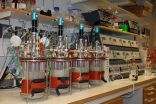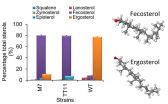(Press-News.org) VIDEO:
This is a video interview with Jens Nielsen.
With a simple mutation, yeast can grow in higher than normal temperatures. Researchers at Chalmers University of Technology demonstrate this in an article...
Click here for more information.
With a simple mutation, yeast can grow in higher than normal temperatures. Researchers at Chalmers University of Technology demonstrate this in an article to be published in the scientific journal Science. The findings may result in ethanol being more effectively manufactured for vehicle fuel, as well as increase the possibility of using residual waste as a raw material.
If industrial yeast cultivation is not cooled, the yeast cells die from the heat they themselves produce. Yeast cultivation is currently cooled to 30 degrees, the temperature at which the yeast cells can best do their job – producing ethanol.
However, the production of bioethanol could be both less expensive and more effective if the temperature could be maintained at 40 degrees. A great deal of money could be saved on the cooling costs, and the risk of bacterial growth would decrease. In addition, the raw material, for example starch, must be broken down into sugars that the yeast can use, a process that functions best at high temperatures.
Researchers at Chalmers University of Technology have now resolved the issue of what makes yeast thermotolerant.
"As it turns out, a simple mutation is sufficient," says Jens Nielsen, professor of systems biology and head of the research team. "Yeast has a molecule in its cell membrane called ergosterol, instead of cholesterol which humans have. The mutation exchanges ergosterol for a more bent molecule called fecosterol. This has several different effects on the cells, which enables the yeast to grow at 40 degrees. "
The yeast has not been gene modified by the researchers; rather, they have used adaptive laboratory evolution to produce it. The method allows new characteristics to be produced without knowing which mutations are required to achieve them.
Three yeast cultivations were subjected to a temperature of about 40 degrees. After just over three months, when over 300 generations had passed, the yeast suddenly started to grow effectively in all three cultivations. The researchers analysed the genetic structure and metabolism in three yeast strains from each cultivation. They concluded that while several different mutations had occurred in the strains, all the strains had the mutation that produced fecosterol.
"Since that mutation took place in three independent cultivations, it appears to be the most important factor in terms of the yeast becoming thermotolerant," says Jens Nielsen. "This shows how rapidly evolution can change an organism. It is interesting that the structure in fecosterol is the same as in sterol-like molecules, which protect some bacteria and plants against high temperatures. "
One important characteristic of the yeast strains is that they are stable – they pass on their thermotolerancy to future generations.
This characteristic, and the fact that the researchers now know exactly what makes yeast thermotolerant, may have a major impact on bioethanol production all over the world. This includes current bioethanol production which is based on sugar beets or corn. Ethanol valued at more than USD 100 billion a year is currently produced using yeast. If even a minor improvement can be introduced into the process, billions of dollars can be saved every year. The results also pertain to future production, which would be the best possible scenario from a climate perspective: production in which the raw product is residual waste from farming and forestry.
"I believe that our results have very great potential for this type of development," says Jens Nielsen. "In order to use residual waste of this kind, the substance lignocellulose must be broken down, which is difficult. The enzymes needed for decomposition work best at high temperatures. "
"From a long-term perspective, our results may also increase the possibility of using yeast to produce more advanced biofuel that more closely resembles oil-based fuel."
INFORMATION:
The scientific journal Science will publish the article entitled "Altered sterol composition renders yeast thermotolerant" on Friday 3 October. It will be published at:
http://www.sciencemag.org/lookup/doi/10.1126/science.1254426
Facts: Bioethanol production:
The dominant technology for producing renewable bioethanol today is decomposition and fermentation of raw materials that contain starch or sugar, primarily sugar beets and corn. World production is approximately 100 billion litres of ethanol a year.
At the same time, a great deal of research is being conducted to find ways to instead utilise residual waste from forestry and farming, for example. This would result in an even greater reduction of greenhouse gases. The difficulty lies in producing industrially viable methods to break down lignocellulose, which is difficult to break down and the substance of which land plants and trees primarily consist. Various projects are ongoing in Sweden and around the world aimed at demonstrating large-scale production of ethanol from various lignocellulose raw products such as straw, corn plants and sugar cane plants.
Facts about the research:
The research has been funded by the Novo Nordisk Foundation, the European Research Council and the Swedish Research Council. It was conducted at Chalmers University of Technology, and the Science for Life Laboratory did the DNA sequencing and bioinformatic analyses.
Thermotolerant yeast can provide more climate-smart ethanol
2014-10-02
ELSE PRESS RELEASES FROM THIS DATE:
Cheetahs never prosper: Energy expenditure linked to population decline
2014-10-02
Wild cheetah populations have declined precipitously in the past century: from an estimated 100,000 in 1900 to only around 10,000 today. A new study from researchers in Europe, South Africa and at North Carolina State University suggests that the energy cheetahs spend looking for prey, rather than their high-speed hunting tactics or food stolen by other predators, may be to blame for their dwindling numbers.
Cheetahs are high-speed hunters, but are not the strongest predators in their ecosystems. Often, hyenas and lions will take advantage of this, stealing the cheetah's ...
Princeton scientists observe elusive particle that is its own antiparticle
2014-10-02
VIDEO:
Princeton University researchers first deposited iron atoms onto a lead surface to create an atomically thin wire. They then used a scanning-tunneling microscope to create a magnetic field and to...
Click here for more information.
Princeton University scientists have observed an exotic particle that behaves simultaneously like matter and antimatter, a feat of math and engineering that could yield powerful computers based on quantum mechanics.
Using a two-story-tall microscope ...
HIV pandemic's origins located
2014-10-02
The HIV pandemic with us today is almost certain to have begun its global spread from Kinshasa, the capital of the Democratic Republic of the Congo (DRC), according to a new study.
An international team, led by Oxford University and University of Leuven scientists, has reconstructed the genetic history of the HIV-1 group M pandemic, the event that saw HIV spread across the African continent and around the world, and concluded that it originated in Kinshasa. The team's analysis suggests that the common ancestor of group M is highly likely to have emerged in Kinshasa around ...
New map exposes previously unseen details of seafloor
2014-10-02
Accessing two previously untapped streams of satellite data, scientists at Scripps Institution of Oceanography at UC San Diego and their colleagues have created a new map of the world's seafloor, creating a much more vivid picture of the structures that make up the deepest, least-explored parts of the ocean. Thousands of previously uncharted mountains rising from the seafloor and new clues about the formation of the continents have emerged through the new map, which is twice as accurate as the previous version produced nearly 20 years ago.
Developed using a scientific ...
New study suggests humans to blame for plummeting numbers of cheetahs
2014-10-02
A new study led by Queen's University Belfast into how cheetahs burn energy suggests that human activity, rather than larger predators, may force them to expend more energy and thus be the major cause of their decline.
Wild cheetahs are down to under 10,000 from 100,000 a century ago with conventional wisdom blaming bigger predators for monopolising available food as their habitat becomes restricted. The traditional thinking has been that cheetahs no longer have sufficient access to prey to fuel their enormous energy output when engaging in super-fast chases.
But, ...
New approach to boosting biofuel production
2014-10-02
CAMBRIDGE, MA -- Yeast are commonly used to transform corn and other plant materials into biofuels such as ethanol. However, large concentrations of ethanol can be toxic to yeast, which has limited the production capacity of many yeast strains used in industry.
"Toxicity is probably the single most important problem in cost-effective biofuels production," says Gregory Stephanopoulos, the Willard Henry Dow Professor of Chemical Engineering at MIT.
Now Stephanopoulos and colleagues at MIT and the Whitehead Institute for Biomedical Research have identified a new way to ...
Falling asleep: Revealing the point of transition
2014-10-02
How can we tell when someone has fallen asleep? To answer this question, scientists at Massachusetts General Hospital have developed a new statistical method and behavioural task to track the dynamic process of falling asleep.
Dr Michael Prerau, Dr Patrick Purdon, and their colleagues used the evolution of brain activity, behaviour, and other physiological signals during the sleep onset process to automatically track the continuous changes in wakefulness experienced as a subject falls asleep.
The study, publishing today in PLOS Computational Biology, suggests that it ...
Researchers identify new pathway linking the brain to high blood pressure
2014-10-02
VIDEO:
Dr. Frans Leenen, from the University of Ottawa Heart Institute, discusses the importance of these new findings.
Click here for more information.
Ottawa, ON and Baltimore, MD, October 2, 2014—New research by scientists at the Ottawa Heart Institute and the University of Maryland School of Medicine (UM SOM) has uncovered a new pathway by which the brain uses an unusual steroid to control blood pressure. The study, which also suggests new approaches for treating high blood ...
York academics reveal new findings about insect diversification
2014-10-02
Biologists from the University of York have compiled two new datasets on insect evolution, revealing that metamorphosing insects diversify more quickly than other insects and are therefore the biggest contributors to the evolution of insect diversity.
Both funded by the Natural Environment Research Council (NERC), the first dataset is a complete fossil catalogue showing timescales of origination and extinction of different families of insects. Working with the Natural History Museum and National Museums Scotland, former PhD student Dr David Nicholson collated a database ...
A closer look at the perfect fluid
2014-10-02
By combining data from two high-energy accelerators, nuclear scientists have refined the measurement of a remarkable property of exotic matter known as quark-gluon plasma. The findings reveal new aspects of the ultra-hot, "perfect fluid" that give clues to the state of the young universe just microseconds after the big bang.
The multi-institutional team known as the JET Collaboration, led by researchers at the U.S. Department of Energy's Lawrence Berkeley National Lab (Berkeley Lab), published their results in a recent issue of Physical Review C. The JET Collaboration ...







